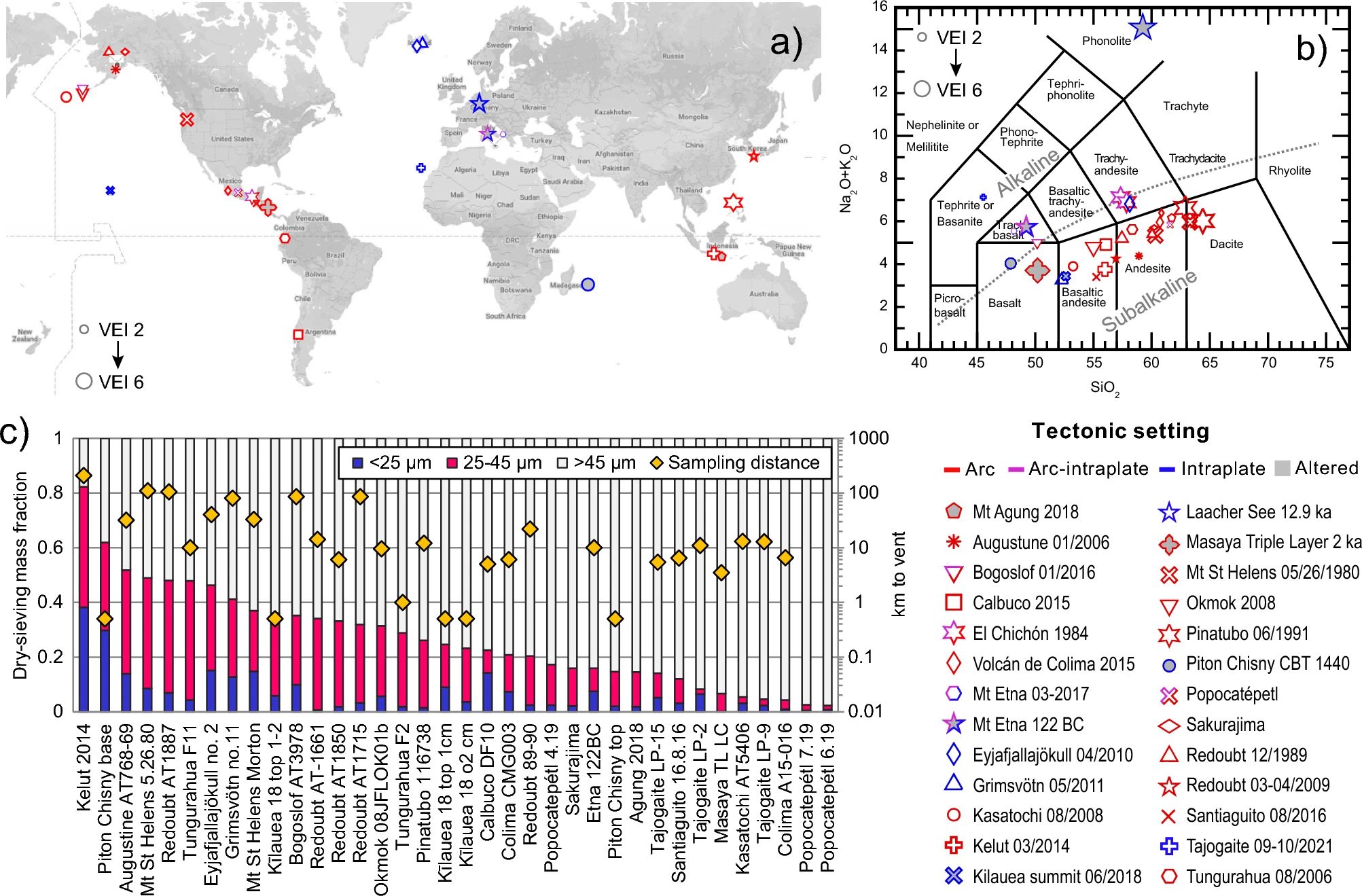
Volcanic ash is no ordinary dust: It gets injected into the atmosphere, climbs to the stratosphere, impacts climate, powders roadways and clogs jet engines.
To bridge the knowledge gap between volcanologists and atmospheric scientists working on climate change and observing global systems, Cornell researchers have characterized volcanic ash samples from many explosive eruptions of a broad compositional range. The work is helping scientists uncover how this tiny material – measured in microns and nanometers – plays a big role in the atmosphere.
Volcanic ash is formed from minerals trapped in a silicate glass, as shown here under a microscope. Reactions with gases from the volcanic plume and atmosphere also form salt crystals on the ash surface, like these asterisk-shaped salts on an ash particle from the 2021 Tajogaite eruption on La Palma, in the Canary Islands, Spain.
The work, “Phases in Fine Volcanic Ash,” was published Sept. 21 in Scientific Reports.
“Large volcanic eruptions can have measurable impacts on climate that last for years or even decades,” said first author Adrian Hornby, a postdoctoral researcher in the Department of Earth and Atmospheric Sciences. “The dispersion and transport of fine volcanic ash and its interaction with the Earth touch on various disciplines – from atmospheric science and climate modeling to environmental studies and even public health.”
Volcanoes can be created by hot spots deep within the Earth’s mantle, like those in Hawaii, or they can form in subduction zones, where two tectonic plates collide. But each has distinct fingerprint-like compositions that can trigger a variety of environmental problems that pose complications for the planet.
The ash from volcanoes is a complex particulate material formed from the fragmentation of magma and injected into the atmosphere during explosive volcanic eruptions, Hornby said.
“The ash contains fractions of minerals, silicate glass and pores, but the expected composition and properties produced in eruptions are poorly defined,” Hornby said. “This is true for fine volcanic ash that gets transport widely in the atmosphere, creating a broad set of impacts on the Earth system, infrastructure and human health.”
Due to a dearth of data, the scientific community had been relying on rough approximations or poor models of ash composition. Now, the Cornell group collected samples from 40 eruptions, characterized by their size and tectonic background, to provide a better, comprehensive dataset. They focused on volcanic ash grains smaller than 45 microns, which is relevant because atmospheric winds can transport it and prompting wider impact.
They found that the composition of volcanic ash varies significantly with grain size, tectonic setting and chemistry. As grain size became finer, there was an increase in fractions of crystalline silica (which, if you breathe it in, can cause health ailments and lung cancer) and salts, while the components glass and iron oxide decreased.
In their sieved samples – ranging from places like Mount Pinatubo, Philippines (1991), Mount St. Helens, Washington (1980) and Mount Etna, Italy (122 BC) and La Palma, Canary Islands, Spain (2021) – from 23 volcanoes, the group used X-ray diffraction to detect the atomic structure of materials, and to identify and measure the proportions of minerals and glass with improved methods, and scanning electron microscope to confirm phases, evaluate morphology and textures.
The samples varied widely in their mineral content: Pinatubo produced a lot of feldspar (an abundant group of aluminosilicate minerals from the Earth’s crust) and amphibole (an important mineral in volcanic explosivity), and quartz evidence of significant melt evolution by fractional crystallization and other processes before the eruption.
On the other extreme, the 2021 Tajogaite eruptions in La Palma, Canary Island, Spain, the mineral load was mostly feldspar, clinopyroxene and olivine – the last one a mineral characteristic of primitive melts with little evolution from their mantle source.
Hornby said that for samples collected during the 2021 Tajogaite, the average amount of glass decreased from 50% to 35% while the fractions of dense, iron-bearing minerals increased from 35% to 50%. Salts increased for finer particles in all cases.
“In finer grain ash, we saw a significant increase in salt,” said senior author Esteban Gazel, the Charles N. Mellowes Professor in Engineering. “That’s important because salts are easy to dissolve. Salt will be the first thing that gets dissolved when the fine ash reaches the ocean. You don’t want to breathe it in, as it will react with your lungs.”
Volcanic ash, by the nature of its voluminous production, atmospheric transport and deposition into every known ecosystem, is the most interdisciplinary aspect of volcanism. “Our study provides the first data-driven resource to better constrain volcanic ash mineral and glass composition and density needed for atmospheric scientists to examine ash transport and better understand its effects on the Earth system,” said Gazel, who is also a faculty fellow at the Cornell Atkinson Center for Sustainability.
Ash density is controlled by the mineral content. “Regardless of size, regardless of the origin of the magma,” Hornby said, “we were able to obtain a reasonably good density estimate from the minerals and iron oxides.”
This atmospheric ash can go long distances to impact climate and ecosystems – even on other continents – far from the volcano. “Atmospheric scientists have been ignoring the impact of ash on climate and biogeochemistry,” said co-senior author Natalie Mahowald, the Irving Porter Church Professor in Engineering. “With this research, we finally have the data to estimate the impact.”
